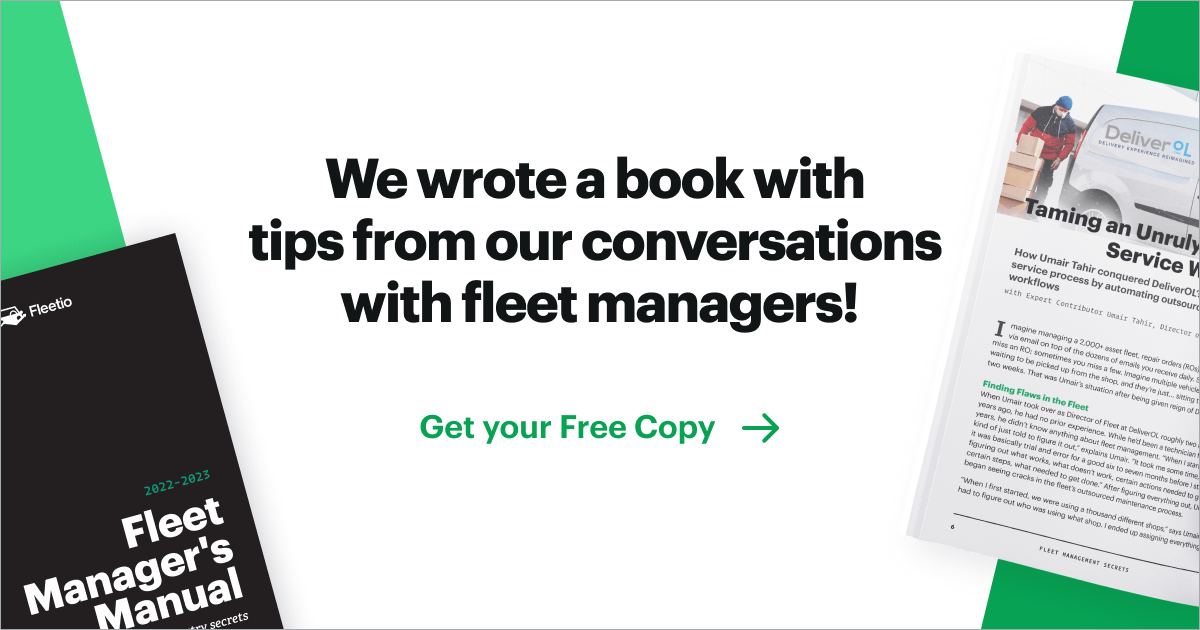We’ve put together a couple tips from our conversation with Herman VanDenBogaert of Cherrylake on how to optimize your maintenance processes to avoid big downtimes.
Herman VanDenBogaert is the raw materials purchasing manager for Cherrylake, a landscaping and construction company based out of central Florida. Cherrylake manages over 370 vehicles across four different divisions, and it’s Herman’s job to streamline maintenance processes in a way that minimizes downtime and prioritizes cost savings.
We spoke with Herman to learn more about how a focus on fleet data can help reduce breakdowns for both vehicles and equipment. Here’s a couple of our takeaways from that conversation.
1. Make sure all of your fleet’s maintenance data points are united in one spot to ease communication and reporting.
Cherrylake was struggling with the same problem that many fleets encounter – a lack of centralization of maintenance data.
"There was data for our fleet in like, twelve different data points, and there was no one thing that was kind of feeding them all together," Herman said. "Any time I made a change or someone else made a change in the fleet, I was having to keep up with all these databases."
The company switched to Fleetio as a way to keep all of those important touch points without having to completely start from scratch, using data integrations to bring all the information into Fleetio.
"With Fleetio, using the inspections, getting issues made, being able to communicate that straight to my mechanics, and they repair it the next day and sign off on it, everything gets knocked out. It’s become a routine now.
"So now, it’s like, ‘Hey man, what vehicle do you want to look at? Here’s all the repairs, here’s all the issues we had and what we did, here’s how much it cost.’ Those types of things, you don’t think about it now but in the past, it really dragged us down and took a lot of time and effort."
2. Follow the numbers to see where your operation is suffering.
As a purchaser, Herman lives on the financial side of Cherrylake’s operations, so the best way to figure out what was happening on the technical side of the fleet was to look at what he knows – the numbers. In the process, he found an inefficiency in the mechanics’ service hours that was leading to bigger problems down the road.
"I had three mechanics, and I started to ask, ‘How much time are they spending doing repairs compared to preventive?’ We were being reactive instead of proactive."
Once they began to isolate the source of their maintenance hangups, Cherrylake was able to not only avoid more breakdowns with preventive maintenance, but create massive savings on their maintenance budget.
"Our repair costs were above half a million dollars, for sure, and we had a smaller fleet then. We minimized that down to around $350,000.
"We’re starting to break it down to, ‘What things are we buying for preventive maintenance, and what things are repair costs? What things are outside repair costs?’ We’re really trying to break down that $350,000 and say, ‘Are we doing a good job? What kind of costs could we cut if we had another mechanic to take care of some of this outside service work?’"
3. Prioritize proactive maintenance to avoid reactive maintenance.
Being able to identify the time spent on proactive and reactive maintenance, and the cost associated with those repairs, created a new mindset for Herman.
"It’s minors and majors, right? I want minors all day long."
Cherrylake started to encourage smaller, more regular preventive action to stave off the events that cause catastrophic breakdowns – simple things like making sure equipment is well oiled, and that vehicles are scheduled for standard maintenance on a recurring basis.
"Our team was throwing a lot of money into repairs instead of preventive [maintenance]. We have some of these larger loaders, and when you have a repair that’s like, ‘I need brakes on this loader…’ It costs you $12,000 to $20,000. They’re these huge machines. So that got us more like, ‘Hey, make sure you guys are greasing, using the right fluids.’"
4. More vehicles mean more breakdowns, and spare vehicles don’t always save you downtime.
Maintenance and repairs are, of course, unavoidable even with the best of processes, and because of that, some fleets resort to keeping more vehicles than are needed on queue for when those breakdowns occur. But one thing that Herman learned in prioritizing preventive maintenance is that if you pay attention to the PM schedule, having those extra vehicles can turn out to be a burden in the long run.
"Before, we were having a lot of issues with guys not having a truck for a week and a half, two weeks, and then having to keep vehicles in our fleet that were just used as spares," he said. "Imagine the costs, right? You’re depreciating two big trucks for a couple more years and that adds up quick."
"We used to keep at least two spare to three spare trucks, not including our shared vehicles, and we really don’t do that anymore. We don’t have any kind of spare truck."
5. Pay attention to the common issues to avoid big repairs.
Something else Herman found in his analysis was that there were repetitive services that were accounting for most of their maintenance and inventory costs.
"Tires, man. They’re on everything you’ve got, right? And if people don’t mind it or take care of it, those are the big ones that can just cause a lot more damage and problems.
"We go through thousands and thousands of dollars of tires. We’ve got a lot of flatbed trailers to pull tree material all day every day, and we have a lot of mechanics that lose time on these roadside calls because these guys have blowouts. When you have to pay someone else to do it on a weekend or night, it’s expensive."
In order to lessen the impact their tire costs have on the fleet, Herman has operators paying closer attention to the details of their pre-trip inspections to catch things before they create a major maintenance event. By checking on things like tires, brakes and fluid on a daily basis, it’s less likely a potential issue will slip through the cracks.
6. Create a controlled process for handling repairs with less steps and more direct communication.
Cherrylake’s communication around breakdowns looked way different before Herman first took over in his role, and the inefficiency in that process exacerbated both the downtime on vehicles and equipment as well as impacting performance in the field.
"There would be two or three people involved before the mechanic – the operator’s manager, then whoever the fleet manager is, and then communicating back to the shop," he said. "And sometimes the operator would just show up and say this is broken, and then he’s not in the field, the manager doesn’t know where he’s at."
Along with the chaos in the field, jobs and equipment would begin piling up in the shop and create a nightmare for technicians.
"[A piece of equipment] would be broken in the middle of a field, or they come dragging it into the shop with all the other equipment we have here and we’re kind of having to take it on the fly. There was a lot of equipment built up around the shop as people were bringing stuff."
Using Fleetio for service reminders allowed Cherrylake to create a more seamless chain of communication between operators, managers and technicians, which helped speed up service response times and smooth out any issues spurred by the downtime.
7. Standardization can help keep parts inventory and repairs simple.
When procuring new equipment and vehicles, Herman notes that using similar types and brands can help with both decreasing time in the shop and reducing the cost of parts. "We like to share the same types of equipment with our three branches, so if we buy a Volvo loader for the farm, we’ll buy a Volvo loader for construction," he said. "So then we’ve got those parts on shelf [in the shop], and when they say we need a tire, we already have one mounted to a wheel.
"When our mechanic’s looking at the service reminders, and he sorts it by groups, he knows ‘Hey, those are all Koboda 7401s, I’m going to need five of these filters.’"
Want to learn more about how Fleetio helped Cherrylake streamline all its fleet processes? Check out their story here, or check out Fleetio yourself with a 14-day free trial!




